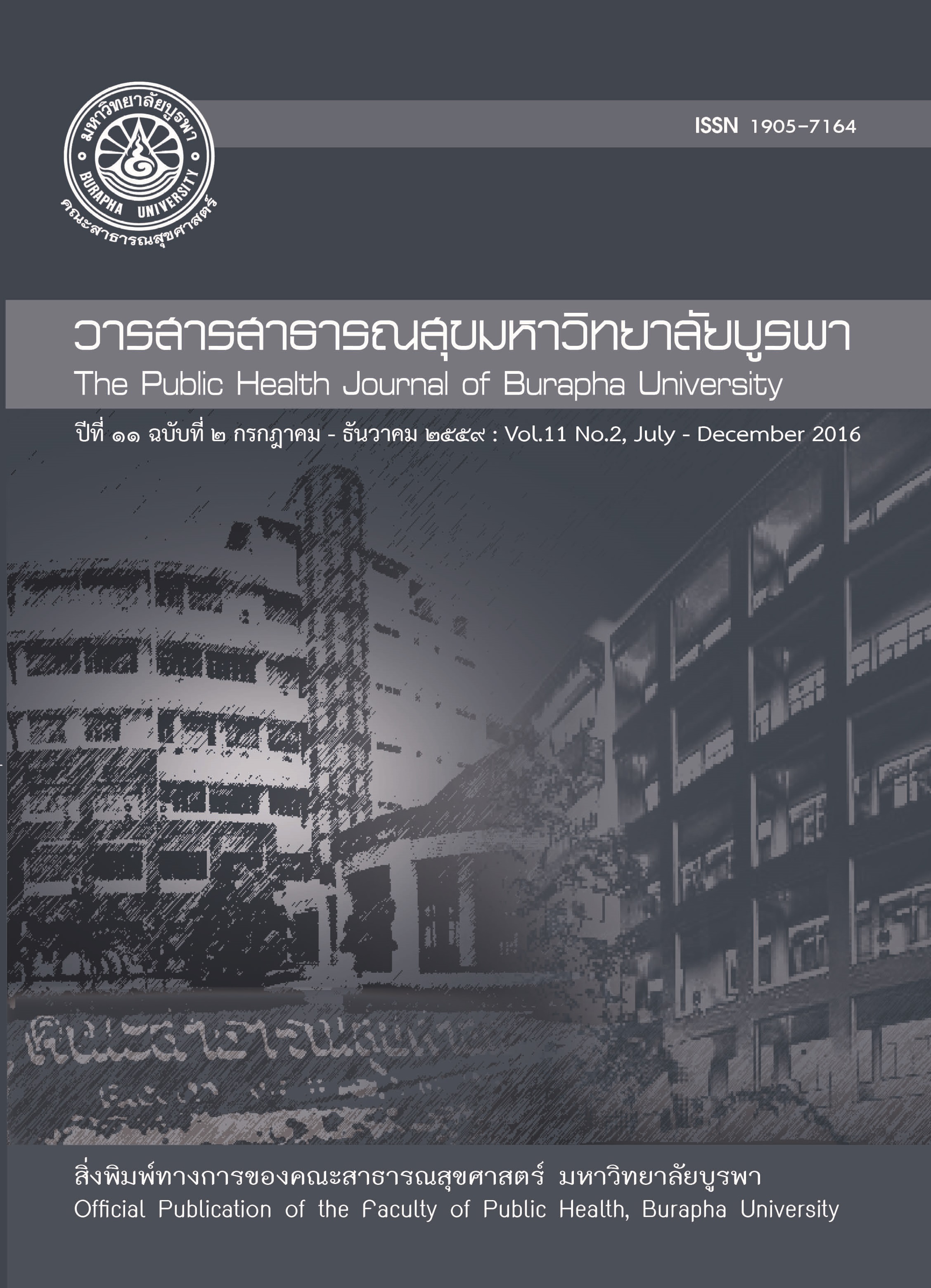ความต้องการในการจัดบริการการดูแลผู้สูงอายุแบบไปกลับ
Main Article Content
บทคัดย่อ
Assessing Needs for the Elderly Day Care Services
The descriptive research aims to explore the basic needs of day care services. A total of 384 out- patients at the Burapha university hospital were selected to participate in this study. Simple random sampling was used to select the subjects from the out-patient department visiting lists. Data were collected by the researchers' team using the questionnaires at Burapha University Hospital. Descriptive statistics was used for data analysis. The results revealed that most participants reported physical structure of the day care should include a living room, a religious activity room, an area for doing activities together, an outdoor relaxing area, and an indoor and outdoor exercise areas (92.2 % 88.8%, 79.9%, 75%, 74.5%, and 73.4% respectively). For basic needs of services, most participants reported that the day care services should provide health promotion activities, an ambulance for emergency service, oral health service twice a year, lunch and supper meals, basic health assessment once a month, relaxing activities, and transportation service from home to the day care (93.5%, 93.0 %, 91.9%, 91.7%, 89.6%, 84.1%, and 81.3 % respectively). Furthermore, 76.6 % of the participants reported that the day care was needed in their communities, 74.2 % was interested to use it, and 93.8 % informed that it was valuable for them. Therefore, the needs of the stakeholders should be taken into consideration in establishing the elderly day care, which would result in the highest benefit for development of appropriate day care model for the elderly people.
การวิจัยครั้งนี้เป็นการวิจัยเชิงพรรณนา (Descriptive research) เพื่อศึกษาความต้องการพื้นฐานในการจัดบริการการดูแลผู้สูงอายุแบบไปกลับ กลุ่มตัวอย่างที่ใช้ในการศึกษาคือผู้ที่มารับบริการ ณ แผนกผู้ป่วยนอกโรงพยาบาลมหาวิทยาลัยบูรพาจำนวน 384 คน โดยการสุ่มอย่างง่ายจากรายชื่อผู้เข้ารับบริการที่แผนกผู้ป่วยนอก การเก็บรวบรวมข้อมูลโดยใช้แบบสอบถามและวิเคราะห์ข้อมูลโดยใช้สถิติพรรณนา
ผลการศึกษาพบว่า กลุ่มตัวอย่างส่วนใหญ่เห็นว่าสถานบริการแบบไปกลับควรมีห้องพักผ่อนหรือดูทีวีส่วนกลาง มีห้องทำกิจกรรมทางศาสนา มีห้องหรือพื้นที่ส่วนกลางสำหรับทำกิจกรรมร่วมกัน มีบริเวณที่เป็นสนามหญ้าหรือสวนหย่อมเพื่อใช้ในพักผ่อน มีพื้นที่สำหรับออกกำลังกายทั้งในร่มและกลางแจ้ง ร้อยละ 92.2 88.8 79.9 75 74.5 และ73.4 ตามลำดับ สำหรับความต้องการด้านการบริการพบว่ากลุ่มตัวอย่างส่วนใหญ่คิดว่าสถานบริการดูแลผู้สูงอายุแบบไปกลับควรมีกิจกรรมการส่งเสริมสุขภาพ หรือกิจกรรมการให้ความรู้ด้านสุขภาพแก่ผู้สูงอายุ มีบริการรถรับส่งกรณีอุบัติเหตุฉุกเฉิน มีกิจกรรมตรวจสุขภาพฟันให้ผู้สูงอายุ ปีละ 2 ครั้ง มีการจัดเตรียมอาหารกลางวัน และอาหารว่างให้ผู้สูงอายุ มีกิจกรรมตรวจสุขภาพเบื้องต้นให้ผู้สูงอายุเดือนละ 1 ครั้ง มีกิจกรรมนันทนาการให้แก่ผู้สูงอายุ และมีบริการรถรับส่งที่บ้านร้อยละ 93.5 93.0 91.9 91.7 89.6 84.1 และ 81.3 ตามลำดับ นอกจากนี้ร้อยละ 76.6 กลุ่มตัวอย่างมีความต้องการให้มีสถานบริการดูแลผู้สูงอายุแบบไปกลับในชุมชน ร้อยละ74.2 มีความสนใจไปใช้บริการสถานบริการดูแลผู้สูงอายุแบบไปกลับ และคิดว่าถ้ามีสถานบริการดูแลผู้สูงอายุแบบไปกลับในชุมชนมีประโยชน์มากต่อกลุ่มตัวอย่างถึงร้อยละ 93.8 ดังนั้นการพัฒนารูปแบบบริการสำหรับผู้สูงอายุแบบไปกลับนั้นควรพิจารณาถึงความต้องการของประชาชนในชุมชนผู้ที่มีส่วนได้ส่วนเสีย ซึ่งจะส่งผลให้เกิดประโยชน์สูงสุดกับการพัฒนารูปแบบการดูแลที่เหมาะสมกับผู้สูงอายุต่อไป
Article Details
เอกสารอ้างอิง
New York: The United Nations Population Fund; 2012.
2. สถาบันวิจัยและพัฒนาผู้สูงอายุไทย. รายงาน ประจำปีสถานการณ์ผู้สูงอายุไทย พ.ศ.2555. นนทบุรี:
คณะกรรมการผู้สูงอายุแห่งชาติ; 2555.
3. Jitapunkul S, Chayovan N, Yodpetch S. Elderly in Thailand: An extensive review of
current data and situation and policy and research suggestions (in Thailand). Bangkok:
The Thailand Research Fund; 2001.
4. Oiu WQ, Dean M, Liu T, Geotge L, Gann M, Cohen J, Bruce ML. Physical and mental
health of homebound elderly: An overlook population. Journal of American Geriatric Society. 2011; 58(12): 2423-2428.
5. Freid VM, Bernstein AB, Bush MA. Multiple chronic conditions among adults aged 45 and
over: Trends over the past 10 years. (online).2012. (cited 2014 September 6). Available from: http://www.cdc.gov, 2014.
6. Lehman CA, Poindexter A. Gerontological nursing: Competencies for care. In KL Mauk (Ed.),
The ageing population. Massachusetts: Jone and Bartlett; 2006.
7. สำนักงานสถิติแห่งชาติ. การสำรวจผู้สูงอายุไทย. กรุงเทพ: สำนักงานสถิติแห่งชาติ; 2550.
8. เยาวรัตน์ ปรปักษ์ขาม และ พรพันธุ์ บุญยรัตพันธุ์. การสำรวจภาวะสุขภาพอนามัยของประชาชนไทยโดย
การตรวจร่างกาย ครั้งที่ 3 พ.ศ. 2546-2547. กรุงเทพ: สำนักงานพัฒนาระบบข้อมูลข่าวสารสุขภาพ; 2549.
9. มูลนิธิสถาบันวิจัยและพัฒนาผู้สูงอายุไทย. รายงานการสังเคราะห์ระบบการดูแลผู้สูงอายุ
ในระยะยาวสำหรับประเทศไทย. กรุงเทพ: ที คิว พี ; 2553
10. The National Adult Day Services Association. Standard and guideline for adult day services.
Seattle, WA: The National Adult Day Services Association; 2010.
11. กัลยา วานิชย์บัญชา. สถิติสำหรับงานวิจัย. กรุงเทพมหานคร: โรงพิมพ์จุฬาลงกรณ์มหาวิทยาลัย; 2549.
12. กาญจนา พิบูลย์, ภรภัทร เฮงอุดมทรัพย์, Callen B onnie, เวธกา กลิ่นวิชิต, พวงทอง อินใจ และ
คนึงนิจ อุสิมาศ. ปัจจัยที่มีความสัมพันธ์กับภาวะซึมเศร้าในผู้สูงอายุ. ชลบุรี: มหาวิทยาลัยบูรพา; 2553.
13. วิรดา อรรถเมธากุล และ วรรณี ศรีวิลัย. ปัจจัยที่ส่งผลต่อภาวะสุขภาพของผู้สูงอายุ ตำบลคูบัว จังหวัด
ราชบุรี.วารสารวิจัยทางวิทยาศาสตร์สุขภาพ. 2556; 7 (2): 18-28.
14. National Association of Social Workers. National association of social workers standards
for social work practice with family caregiver of older adults. Washington, DC. National
Association of Social Workers; 2010.
15. ศิริพันธุ์ สาสัตย์. ทิศทางและแนวโน้มในการดูแลผู้สูงอายุระยะยาว.วารสารสภาพยาบาล.
2553; 25(3):5-10.
16. Moore KD. Design guideline for adult day services. (online) 2005 (cited 2015 August 1).
Available from: www.aia.org/aiaucmp/groups/ek_public/.../aiap080051.pdf
17. Hsiung HF. Models of long-term care services. In HZ Chen, MF Lee, JJ Cai, HF Mao, SD Lee,
LL Ye, YS Kim (Eds.), Long-term care practice. Taipei: Young Da; 2003.

